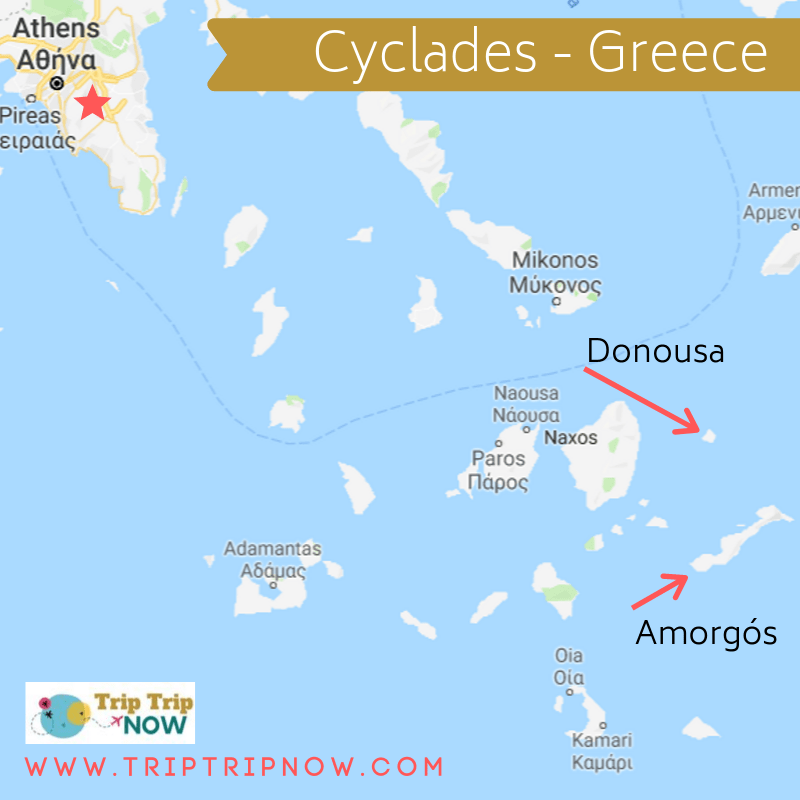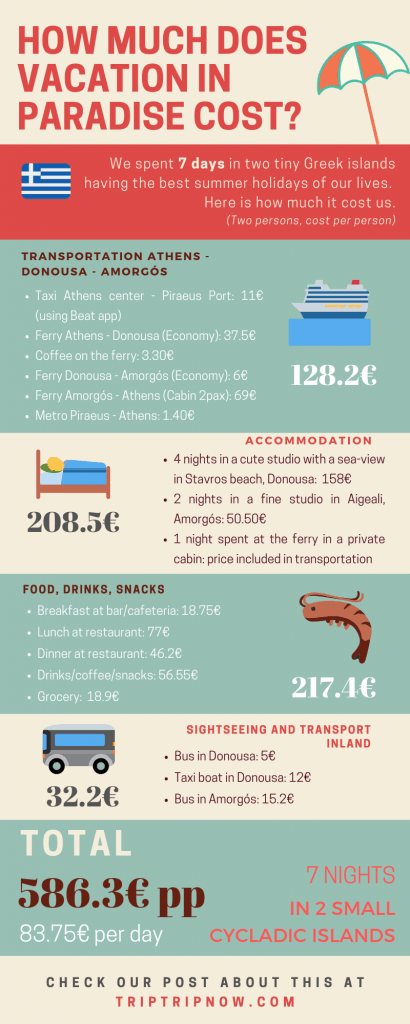If you ever wondered which of the Greek islands is best to visit, don´t wonder anymore. Our bet is for two picturesque little islands, charged with a peaceful vibe, sandy beaches, and that amazing blue-turquoise-emerald sea. They are Donoussa and Amorgós and in this post, we’ll tell our experience with the first, a tiny wild island that (still) is a hidden gem. Come with us!
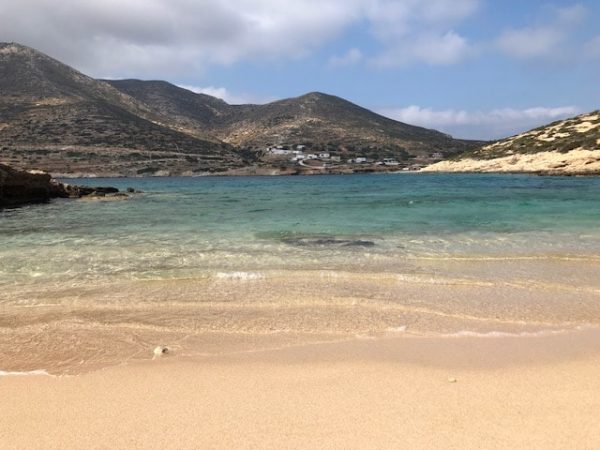
We knew that the Greek islands come in all shapes and sizes. We knew that they can be heaven on Earth if what you wish is sun, sea, beach, nature. We also knew that they can be a magnet for party-goers and hordes of tourists.
When we picked Donousa we just wanted a calm and luminous place to go. We expected little noise and to sleep while listening to the waves against the rocks. We wanted to explore around and NOT by driving. Besides we were really eager to try traditional and modern Greek food with fresh ingredients and a homemade touch.
In Donousa we got all this and a bit more.
Where is Donousa?
Donousa (also spelled Donoussa) is a small island in the Cyclades, in the Aegean sea. It is right in front of Naxos (only 16km) and is on the route to Amorgós (25km), which was our next stop after four and a half days.
When we say Donousa is a tiny island we really mean it: its area is only 13.75 square kilometers. There are around 180 inhabitants in summer and less than 100 in winter. There are no official numbers about how many travelers go there, but we have a hunch that it’s not more than 300 each day.
In Greek mythology, Donousa was the place where Dionisios took Cretan princess Ariadna in order to protect her from the anger of her father Minos (another version says Dionisios took her away from Theseus, the Minotaur myth hero). During the Roman era, Donousa was a place of banishment. Then it was later used as a pirate base. And, finally, Greek authorities didn´t really pay much attention to it. Until recently Donousa was a lost paradise bathed in an emerald sea.
How to get to Donousa
From Athens
Being so small, Donousa obviously doesn’t have an airport and the only way to get there is navigating. Donousa is less than 300 km from Athens, which means around 7 hours in the only ferry route available from the Capital. Our journey started in the Greek Capital, a couple of days before. If you are wondering if it’s worth visiting Athens, please do visit it. Athens is worth a visit not only in summer and also as a solo female traveler.
Blue Star Ferries is the company offering a stop in Donousa from Athens, but attention: the route varies at least 4 times in the year and it only stops there from 3 to 4 times a week.
As we went in August, we got the ferry at 6:45 in Piraeus. We bought it directly on Blue Star Ferries website, which is not a super easy website but everything worked out fine.
We bought an economy ticket for 37.5€. It was the cheapest one and we really didn’t think this would be a big deal to travel in economy, which means sitting in ordinary chairs around the ferry. However, when we do this again, we’ll certainly buy AirSeats, which are bus-like seats, meaning much more comfort and some decent sleep. The reason is that the trip starts so early and, for us, it was a hard time to be awake in uncomfortable chairs for so many hours.
[2021 Update] On our first trip to Donousa, there were no electronic tickets in Blue Star Ferries, only printed ones. In 2021, this is not the case anymore. Today, we recommend searching and buying tickets in companies like Ferryhopper, which offers a wider view of all routes and ferries available. Besides, tickets are digital and it’s not necessary to print them. Having them on the mobile is enough to go onboard.
Besides the cold wind and our zombie state for having onboarded around 6am, the ferry itself is not bad at all. There is a café with a big offer of pastries, sandwiches, and beverages. There is also a burger cafeteria that opens around 10 am. Against what we expected, prices were not outrageously expensive.
But what amazed us more during the ferry trip was the number of travelers taking their dogs with them. At a certain point, we watched a dog-barking opera, which was quite fun.
From Naxos or Amorgós
Another way of getting to Donousa is reaching it by ferry from Naxos and Amorgós. Besides Blue Star, there is also another company operating in this route, on a local level. It is Small Cyclades Lines and its ferries (called Skopelitis) are way simpler than the Blue Star ones.
We didn’t try this line but we heard from other travelers that Blue Star is far better. So it’s up to you to try it and tell the world how it goes 🙂
How is Donousa?
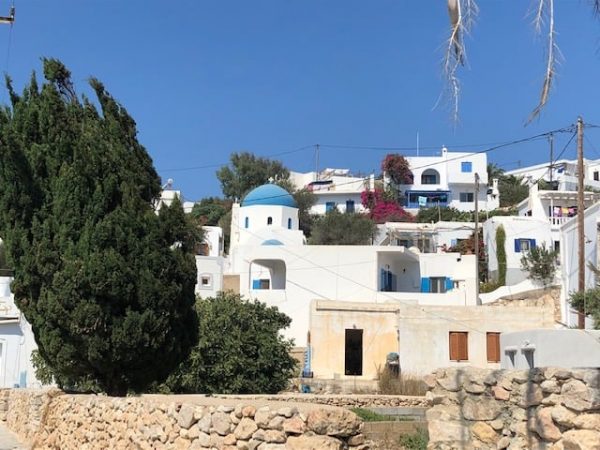
Although it departed on time, the ferry got to Donousa an hour late. We suspected the stop on Paros (the first one) took too long and talking to other people we realized that the delays are not so uncommon. But it didn’t matter at all because we were so excited to get there.
Our first impression was to be in a kind of forgotten piece of land somewhere in the middle of the sea. The first stops (Paros and Naxos) showed us towns along the sea, the typical whitewashed houses from the Mediterranean. Donousa has a few (really a few!) houses, around 250 cats, a tiny port, and A LOT of empty spaces. For us, it was love at first sight.
On our first day, we explored the main village and it took less than 15 minutes. Donousa has two minimarkets that serve both travelers and locals. Be comprehensive: there is a limited variety of food, like fruit, vegetables, and yogurt (tip: take your own bags to avoid getting plastic bags).
If you need sunscreen, the minimarkets won’t help you. You can get it at the souvenir shop in the port. By the way, if you’d like to buy something, Donousa has only two small stores and they are both dedicated to souvenirs, some clothing, and handmade items. And that’s it.
First: cars are sparse
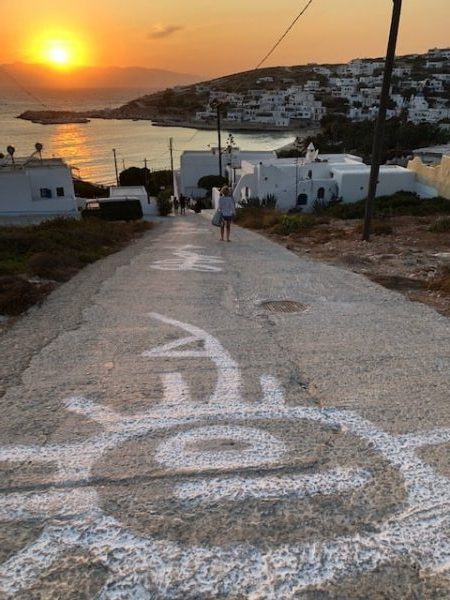
It’s not that cars are not allowed. Some inhabitants of the island do have cars, but there is neither a gas station nor car rental (meaning, it is a silent island!). You can come with your car or bike on the ferry, but remember to bring it fully fuel-charged.
In our case, we did not want to drive at all and the lack of motor engines running was one of the key factors in our decision to come here.
But we were picked up in a car by Loukas, our host. He and everyone else that owns an accommodation business go there to welcome their new guests. We loved this!
On our way to Makares Studios, Loukas wrapped up the essential information we had to know about the island, which is:
- Donousa has 4 beaches. The main one is Stavros beach, right there in the port. There are also Kedros, Livadi and Kalotaritissa.
- Kedros is at a 5-minute walk from our Studios.
- Livadi is reachable by the only taxi-boat that leaves every day at various hours or on foot (1h20 minutes more or less)
- Kalotaritissa is reachable by the only bus that rides every day at various hours or on foot (we didn’t ask how long, but we suppose this would be around 2-3 hours).
- Donousa has 3 villages. Stavros, where we were, is the “big” one. The others are Messaria (4km away) and Mersini (5km away).
- Donousa has 6 trails, all well signaled.
- It also has a few bars, cafés, restaurants and taverns. All of them serve homemade meals with fresh ingredients, just like a sweet mama would do.
The beaches in Donousa
Get ready for many tones of green and blue, crystal clear waters, hippies, and a windy August. Our general impression of the beaches in Donousa is that they are very clean (although we did find some trash, but definitely nothing compared with a touristy destination like Mikonos or Santorini, for example).
Do not expect to find showers or toilets. No. On three of the beaches, however, there is at least a bar or tavern.
Regarding the nationality of the folks we met toasting under the sun, there were some foreigners, but we also heard a lot of Greek. Except for Stavros (the beach at the port), all the other beaches had fully naked bathers and this is the most natural thing, which gives Donousa a hippy-ish touch. Nobody takes stereos or speaks loud. A peaceful vibe is real there.
Stavros beach
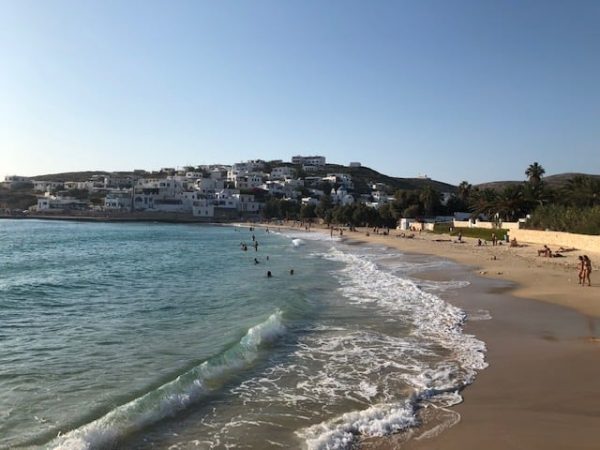
This is the easiest beach because it is right there, in the port, in the heart of the village. Unlike many port beaches, this one has transparent waters and amazing sand. Naturally, this is a family beach (as for its easy access) and it attracts the majority of travelers. However, do not expect facilities like a toilet or handicapped access, or even a shower. None of this exists on the beaches at Donousa.
Unlike all the other beaches on the island, you have practically all the offers of bars and restaurants (and the minimarkets) minutes from your towel. Just in front of the sea, there is perhaps the most beautiful bar-restaurant of Donoussa: Corona Borealis. It has a yard with nice trees and a menu with a great offer of food and beverage. We had a goat dish (common there) and it was very tasty.
Some people take their computer there (who takes a computer to Donousa?!), some people take their dogs there, some people spend the whole afternoon there, and, of course, some people watch the sunset there. While everything happens, great music selection rolls out for hours and hours.
Kedros beach
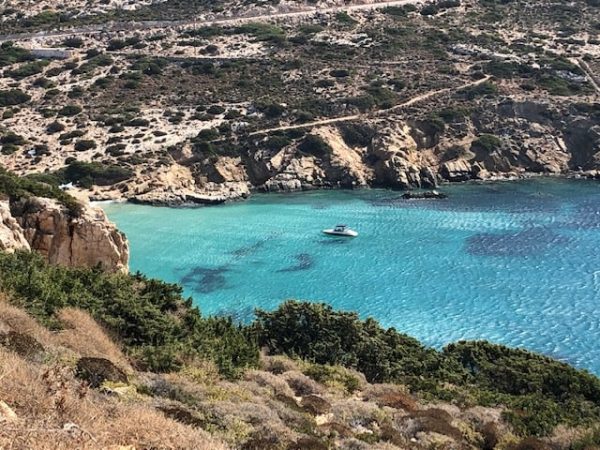
On our second day in Donousa we started exploring the island on foot. Our first destination was Kedros beach at a 10-minute walk from our Studio. You can get there by the only road, get to a point where there is Agnanti Restaurant on your right (they only open for dinner) and a field with happy goats (they are very sociable! If you call, all of them come at once). Then you leave the main road and follow the path. You’ll eventually get to stone stairs that lead to an amazingly beautiful beach down there.
Tip: don’t wear flip-flops for the trail. Prefer proper adventure sandals or even sneakers.
Kedros has one charming bar right in front of the beach. It has lots of tables and couches where some people spend the whole day. You can also work there if you are into it (hope not!). You can simply have a freddo (explain later). You can have lunch (the menu is released at around 12pm). You can just stare at that wonderful emerald sea.
As we went in August, Kedros was the windiest of the beaches in Donousa. It was very, very windy. Which made us swim and play in the water a lot. The seawater, when we were in Donousa, was colder than we expected but once you are in there, swimming and snorkeling, it just doesn’t matter.
And if you swim a bit in Kedros, you’ll see that there is a small boat sunk in the middle of the bay. It’s the black spot we see from above.
Livadi beach and Fokospilia cave
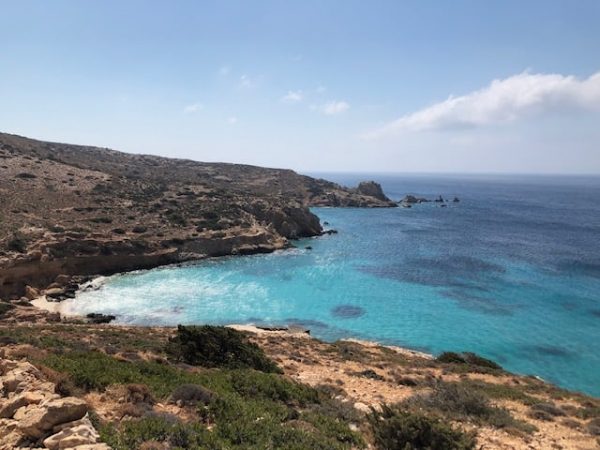
It’s hard to say which beach is the most beautiful in Donousa, but Livadi is bigger and has no bars or taverns. Water is just like everywhere on the island: clear, in different tones of green and blue. The sand is soft as feather. As in Kedros, it was a bit windy too.
Besides the main beach, there’s another one, just beside it, and much smaller. We headed there and spent a couple of hours under the sun.
There are two ways of reaching Livadi, the beach after Kedros. The first is walking to Mersini, an even tinier village about an hour from the port, and then take a 20-minute walk down to reach the sand at Livadi.
We, however, went by the only tour boat available on the island. It cost us 12€ (roundtrip, per person), and included getting to Fokospilia, the “seals cave”. We stayed in Fokospilia for about 20 minutes and it’s very worth taking snorkeling masks with you. It is precious and the tones of blue underwater are worth seeing. We didn´t see any seals though. They are supposed to be there in winter.
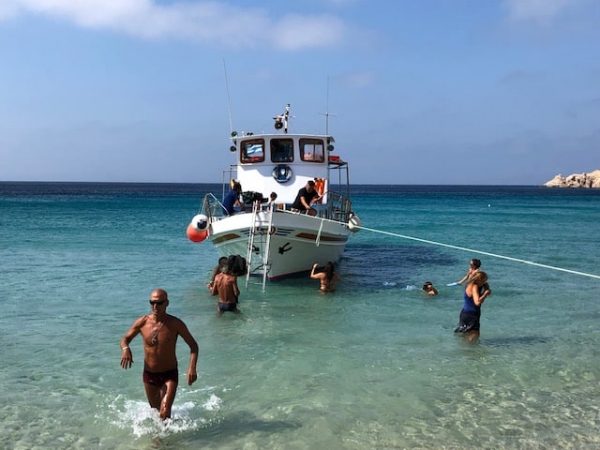
The boat ride is a chapter apart. The boat departs and returns to the port at certain times and if you do a complete trip (the 12€ one), you can come back the time you want. We departed at 11am and got back at 3pm, but we dropped at Kedros, where we had lunch. Both rides were accompanied by traditional Greek music.
When you get to Livadi, there’s no pier. So, people on the beach come help the newcomers doing a straight queue from the boat to the shore to make their bags get to the sand dry and safe. Then you come down the boat into the water. When you are at Livadi, it’s your time to help people get off the boat and bring their stuff safe and dry to the sand.
Kalotaritissa beach
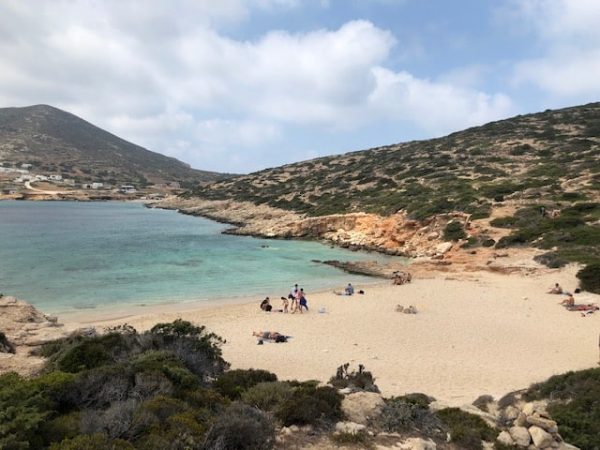
Kalotaritissa is in the extreme North part of Donousa. It’s supposedly less windy than the South part but when we were there, it wasn’t like this. Kalotarittisa has a few houses, a small church and a tavern called Mitsos.
Kalotaritissa has three beaches. All of them are mostly pebbled beaches with rocks under the water, not so soft-sand as the other ones. So, it’s better if you wear swimming sandals, as we did.
The first two beaches you meet when getting there is side by side. We headed to the third one called Trypiti beach. It’s small and a few people were there the day we visited Kalotaritissa. In the most “crowded” moment, there were like 10 people sunbathing or swimming.
The boat that took us to Livadi supposedly goes to Kalotaritissa too, but when we were there it wasn’t operating that route. The only way to reach this part of the island was by walking or by bus (5€ roundtrip). The bus is new, comfortable and safe (despite going on very winding roads!).
We spent our day in Kalotaritissa. Besides sunbathing and eating very well at Mitsos tavern, we walked around to the most extreme part of the island just to have even more breathtaking views. There you see an uninhabited islet called Skilonisi and a lighthouse.
Where to stay in Donousa
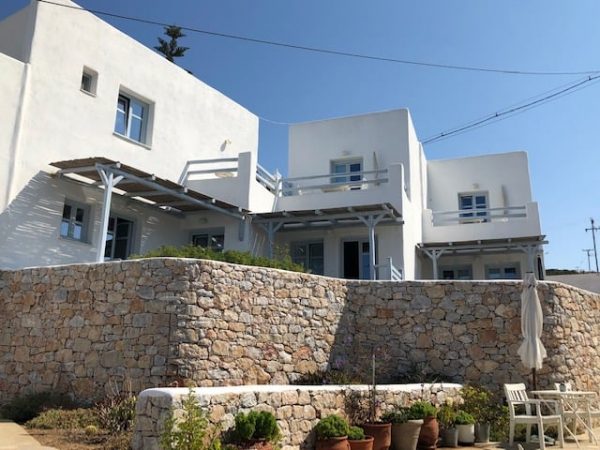
In Donousa there are a few accommodation options but they sell out very quickly in summer. We booked ours four months beforehand and paid less than 80€ for a beautiful studio for a couple.
We chose Makares Apartments, hosted by Loukas since 2014. Makares has self-catering studios with simple and elegant décor. Important to say that it is spotless. It’s on the opposite side of the port, like 100 meters from Stavros beach.
There we slept with the sound of the waves against the rocks. Cooked our own breakfast and had it sitting on the balcony staring at the sea. We met other travelers in the common area and had our siesta in a very comfy bed. In a few words, we loved it.
However, if your type of accommodation is the luxury hotels type, you won’t find that in Donousa. At least not yet.
Find a place to stay in Donousa with Booking.com
How to move around and where to go
Donousa is so small that it’s definitely worth going around it on foot. But if you are a bit lazy for that and did not take your car to the island with you on the ferry, there are only two options: a small musical boat (picture below) and a Mercedes Benz bus. They have their timetable fixed on the port and they leave on time. The boat costs from 3€ to 12€. The bus costs 2.5€ per ride.
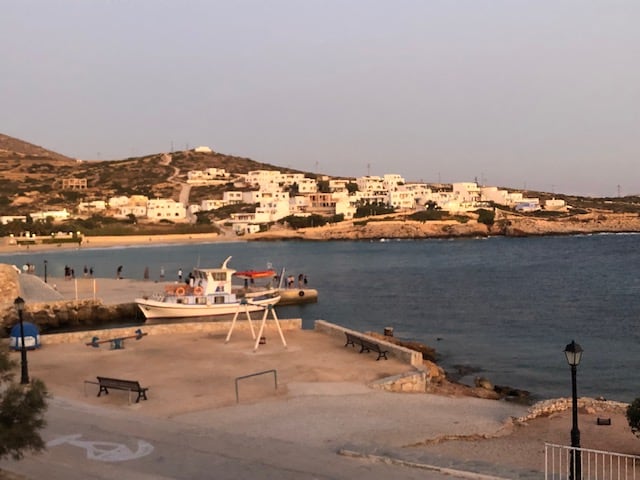
Besides the beaches and caves, Donousa has 6 trails and you see their signs around the island. The longest and most difficult one is to Kalotaritissa. You can check them on a detailed map here.
Where to have great food in Donousa
In Donousa you find mostly Greek foods, but not always. We tried seven bars/restaurants, and the ones we enjoyed most served traditional Greek food. This means having cheese (feta and beyond), vegetables (tomato and eggplant are kings), fish, octopus, goat, chicken, tzatziki (of course), and even pasta with pork.
We were very happily surprised at Ampelaki, which publicizes itself as a “pizza, pasta” place, but this is not accurate. It has a small menu of traditional Greek dishes and they are delicious. The vegetables are from their own garden and the cook is absolutely homemade style. A full dinner there cost us 11€ per person. It is not on the beach first line, but it’s sea-viewing and it was very close to our Studio.
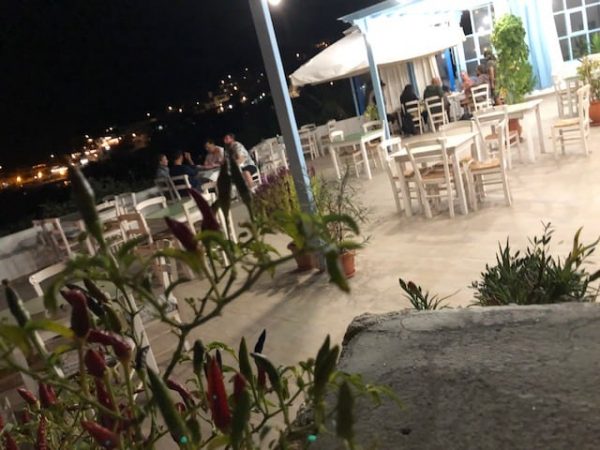
We also enjoyed Mitsos tavern in Kalotaritissa. It’s like Ampelaki: homemade traditional food. A proper lunch there cost us 16.5€ per person.
For light meals, we liked Kedros beach bar. They’ve got an absolutely awesome dessert: lemon mousse with crumble and apples. We had it twice.
And, of course, coffee. Greeks love coffee and we loved all the varieties of freddos we found. Freddo is iced-coffee served in big glasses. Delicious.
How much does it cost to travel to Donousa?
We prepared an infographic with detailed information about how much our 7-days holidays both in Donousa and Amorgós cost. Check it out below.
